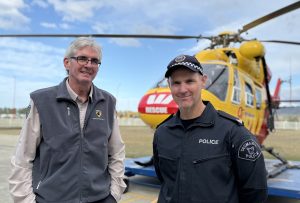Walking in Tasmania's wilderness areas in winter comes with special reward, but Tasmania Police warns there are also greater risks.
The Tasmania Police search and rescue helicopter crew has been called out to almost 200 missions in the 2024/25 financial year, with a number of these rescue incidents avoidable had people undertaken better planning and preparation.
Tasmania Police Search and Rescue Acting Inspector Paul Johns said the winter period often involved the crew attending missions where people had not been prepared for the often-harsh conditions of the Tasmanian wilderness.
One incident involved two walkers who underestimated the terrain and distance of a walk, believing they would complete the track in six hours. The pair was rescued by the helicopter crew after spending a night in near-freezing conditions.
A similar incident involved a family with a small child that spent two nights huddled together in blizzard conditions in the state's north.
The group was unprepared and only equipped for a day's walking. When the weather turned, they became disorientated and lost.
Remote search and rescue personnel located the group the next day and provided medical assistance until the rescue helicopter could attend and extract the group.
Tasmania Police and the Department of Natural Resources and Environment Tasmania joined forces on Tuesday (June 24) to reinforce a winter walking safety message.
Acting Inspector Johns urged people to adequately plan and prepare before they ventured into the Tasmanian outdoors.
"At any time of the year, it's important people research their intended trip, have appropriate equipment and that the walk or the track they are attempting is within their abilities and fitness level," he said.
"Tasmania's weather conditions, particularly in our alpine areas, can change quickly.
"In winter, you have added layers of complexity brought on by difficult conditions such as strong wind, rain, sleet and snow; there are much shorter daylight hours, and you can have very cold to freezing temperatures."
Acting Inspector Johns said it was important people who felt they were in difficulty did not leave it to the last minute to seek advice or raise the alarm.
"Due to the harsh and inclement weather conditions experienced in Tasmania there are times the rescue helicopter will not be able to reach certain locations," he said.
"Rescue personnel will be in attendance however, if you find yourself in a situation where you believe you require assistance, let people or emergency services know as soon as possible.
"Being able to locate people in the wilderness from the helicopter during daylight hours is safer and far less complex than when the sun goes down.
"If, however, you do find yourself requiring assistance at night, a light source of any kind is invaluable. The crew on board the helicopter utilises night vision goggles which enhance any light source, be it a torch or mobile phone."
Advice for bushwalkers
Tasmania Police offers the following advice in reminding bushwalkers of the potential risks in the Tasmanian wilderness.
• Police strongly advise bushwalkers against walking alone, and to ensure they carry sufficient warm clothing and food, and emergency communication devices. A Personal Locator Beacon and preferably also a two-way messaging emergency device (known as a 'SEND' – Satellite Emergency Notification Device) should also be carried. Take sufficient resources even if you are only undertaking a day walk.
• Ensure you're prepared with appropriate equipment - take a map and torch, clothing and footwear to suit any conditions. Have a waterproof jacket; adequate food and water and first-aid kit.
• Research your intended trip. Ensure the trip is within your abilities and fitness level, and you have a route plan, map and check the expected weather forecast. Note that some walks are extremely demanding and should not be conducted without sufficient experience, and ensure you are mentally and physically prepared.
• Let someone know before you go. Ensure someone knows your route and expected return time.
• Always carry a fully charged mobile phone and consider a portable charger to extend battery life. Batteries do not last as long when cold and mobile navigation apps deplete batteries quicker than other apps.
• Be aware that a PLB is a one-way communication device only and the nature of the emergency will not be known by rescue authorities.
• Be mindful that assistance may take some time to arrive depending on the location and weather. You must be prepared to survive until assistance arrives.
• Be flexible and have a contingency plan. Be prepared to turn back or change plans if severe weather is forecast or eventuates during the walk, or the trip is harder than you thought. Making the decision to push on when you should turn back can put you in danger.

Tasmania Parks and Wildlife Service Ranger-in-Charge Brendan Moodie, left, and Tasmania Police Search and Rescue Senior Constable Phil Rule urge bushwalkers to be fully prepared for adventures in the Tasmanian wilderness. Picture: Tasmania Police






